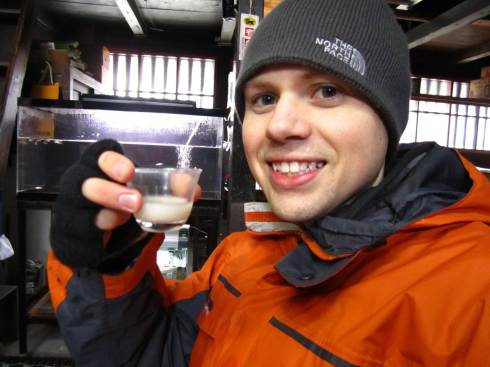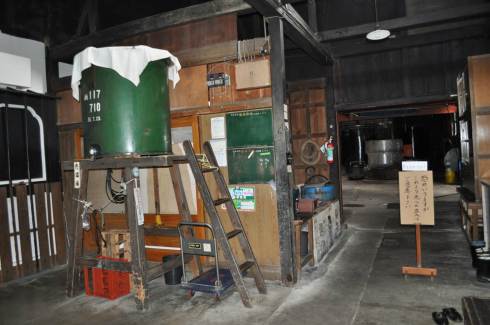You are currently browsing the tag archive for the ‘drinks’ tag.
All regions in Japan claim to be famous for some indigenous industry, and tourists purchase the special local products to take home to friends and family. Takayama, a small ancient mountain town in Gifu Prefecture is famous for beef, wood working, special Spring and Fall Festivals, Sarubobos, and Sake Brewing. In a late winter trip to the town, we wandered through wooden narrow streets and experienced fresh local sake.
Mountain water helped provide pure ingredients, and dozens of famous sake breweries still litter the old castle town’s downtown area occupying old wooden buildings with little to indicate a large brewing operation is taking place behind the walls. After buying a few wooden sake cups at a touristy sake store, we wandered into a quiet street and approached an open door of what seemed like a brewery advertising tastings.
Inside we found a nice brewery owner and some other tourists trying sake in an open room, with industrial barrels and equipment in the back. We pointed at three sake varieties to taste, not being able to read the type. Angela and I have had a very difficult time finding sake we enjoy tasting, but soon found ourselves enjoying the best sake we have come across. Maybe it was the setting, but we quickly narrowed down our favorite and purchased a bottle to take home. The owner gave us a pamphlet in English about enjoying sake for dummies. Most of our best experiences with wine have come from visiting the actual wineries, perhaps we need to discover more sake breweries more local! Problem is the natural water near Tokyo is not optimal for brewing…
But we did discover that breweries often hang a large grass ball outside their doorway, so we are now on the lookout. This may be to signify they have started the brewing season, or is tied to the Shinto religion where sake is sacred, but we aren’t sure as both hypotheses were explained to us by local friends.
In the US, infomercials would often advertise for the “hangover” cure. We had been taught that there was no magic hangover cure but time, and that has proved true until we moved to Japan. Not sure if this wonder product would pass the FDA, but there have been many nights where these “ginger shots” have been essential. Introduced to us by another American friend, we bought them at the local 24/7 convenience store on our walk home from a night of good drinking. Having nothing to lose we tried them, a 3 ounce “shot” that resembles 5 hour energy bottles.
Tasting like a sweet version of the red bull energy drink, they went down easily then we went to sleep. In the morning we had no headache or stomach irritability, when we should have. They are odd as we were functional but still had the fatigue of a hangover, so you are tired but without debilitating headaches or stomach upsetness. Amazing! We now buy these discounted at the local grocery store, to have “just in case.” Upon asking our Japanese friends what they are, they simply reply for heavy drinking and they don’t know what is in them either. There is a ginger root on the bottle, so safe to assume ginger is in them somehow… and they are sold either in the vitamin supplement section or right next to the alcohol (a subtle hint for what they are intended for?) In any case they work, and will be greatly missed when we leave Japan. We will have to store up an emergency cache to mail to ourselves wherever we move to next! Another genius invention in Japan, come visit!
Starbucks in Japan is so interesting.  I love that they cater to the Japanese by promoting seasonal and traditional drinks. February 15th, (I was patiently waiting for the release!) Starbucks Japan released the Sakura latte. Sakura means cherry blossom, and so the beginning of the cherry blossom season begins. I am taking a break from my usual matcha (green tea) latte to enjoy the sakura latte while it lasts. It is pink (which makes me like it even more!) and tastes like a subtle cherry. I’m sure there are other flavors I am missing, but the point is it is fabulous. I even bought a cherry blossom mug to enjoy my sakura latte in. Notice the windows are also covered with cherry blossoms.
I love that they cater to the Japanese by promoting seasonal and traditional drinks. February 15th, (I was patiently waiting for the release!) Starbucks Japan released the Sakura latte. Sakura means cherry blossom, and so the beginning of the cherry blossom season begins. I am taking a break from my usual matcha (green tea) latte to enjoy the sakura latte while it lasts. It is pink (which makes me like it even more!) and tastes like a subtle cherry. I’m sure there are other flavors I am missing, but the point is it is fabulous. I even bought a cherry blossom mug to enjoy my sakura latte in. Notice the windows are also covered with cherry blossoms.
 Always on the search for unique places, we got a tip on an incredible bar in downtown Tokyo through our blog. A random blog comment from the fine folks at Rogue Ales http://www.rogue.com/ in Oregon informed us about a bar with at least 40 beers on tap in the Ryogoku area of Tokyo.
Always on the search for unique places, we got a tip on an incredible bar in downtown Tokyo through our blog. A random blog comment from the fine folks at Rogue Ales http://www.rogue.com/ in Oregon informed us about a bar with at least 40 beers on tap in the Ryogoku area of Tokyo. 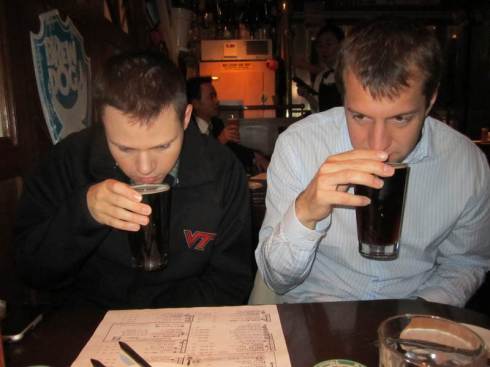 We looked up the place and realized we were near it while visiting Akihabara on a rainy day with our visiting friend Jonathan (another beer enthusiast). The cozy little bar was exactly what was needed on the wet day, and it was better than we could have imagined. We were pleasantly surprised to find that they had expanded to 70 beers on tap, ranging from craft American and European brews to the best locals could offer. Also, unlike the vast majority of bars in Japan, this one was light on the wallet. Their happy hour specials included free appetizers with the purchase of a beer… we were sold!
We looked up the place and realized we were near it while visiting Akihabara on a rainy day with our visiting friend Jonathan (another beer enthusiast). The cozy little bar was exactly what was needed on the wet day, and it was better than we could have imagined. We were pleasantly surprised to find that they had expanded to 70 beers on tap, ranging from craft American and European brews to the best locals could offer. Also, unlike the vast majority of bars in Japan, this one was light on the wallet. Their happy hour specials included free appetizers with the purchase of a beer… we were sold!  It was fall when we visited and enjoyed some delicious Pumking Ale that was well kegged and had an awesome pumpkin aroma. The rest of the beers were quality, but what impressed us the most were the friendly staff. The bar, while larger by Japanese standards, was still rather crowded and 70 taps in the US would take at least a wall. Here they were stacked behind a half bar, which the staff gladly jumped in several pictures with us. By the time we left I had joined their gold club membership and had convinced a waiter to call and get us tickets to a sold out craft brew fest. All in all a very pleasurable experience that the average traveler would never find while visiting Tokyo without some help!
It was fall when we visited and enjoyed some delicious Pumking Ale that was well kegged and had an awesome pumpkin aroma. The rest of the beers were quality, but what impressed us the most were the friendly staff. The bar, while larger by Japanese standards, was still rather crowded and 70 taps in the US would take at least a wall. Here they were stacked behind a half bar, which the staff gladly jumped in several pictures with us. By the time we left I had joined their gold club membership and had convinced a waiter to call and get us tickets to a sold out craft brew fest. All in all a very pleasurable experience that the average traveler would never find while visiting Tokyo without some help!
 My Senior Year of College I enrolled in a Brewing Science class and have ever since been hooked on good, quality beer. When our friend Jonathan came to visit last fall (he had taken the class with me) we spent a day at one of Japan’s largest beer festivals.
My Senior Year of College I enrolled in a Brewing Science class and have ever since been hooked on good, quality beer. When our friend Jonathan came to visit last fall (he had taken the class with me) we spent a day at one of Japan’s largest beer festivals. 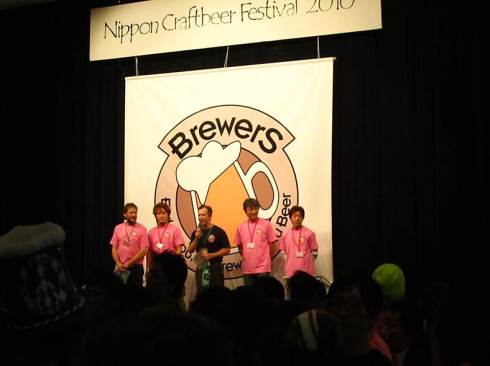 Japan has a large beer industry of great, rice based beers including famous brands such as Yebisu, Sapporo, and Asahi. This beer fest was fashioned as a “homebrew” craft style where there were few, if any, rice beers available. The three of us rode the train to northern Tokyo and found ourselves at the Asahi Beer headquarters building, interesting considering they had nothing to do with the event. With a small admission price we all got a free half pint glass and tickets to try ten beers. The conference hall was packed, with a center aisle full of tapped kegs and a stage at the other end. We decided to dive right in, though we could only read a few of the styles (nearly everything was in Japanese). My overall impression on Japanese craft beer is they get an “A” for effort… but are missing something.
Japan has a large beer industry of great, rice based beers including famous brands such as Yebisu, Sapporo, and Asahi. This beer fest was fashioned as a “homebrew” craft style where there were few, if any, rice beers available. The three of us rode the train to northern Tokyo and found ourselves at the Asahi Beer headquarters building, interesting considering they had nothing to do with the event. With a small admission price we all got a free half pint glass and tickets to try ten beers. The conference hall was packed, with a center aisle full of tapped kegs and a stage at the other end. We decided to dive right in, though we could only read a few of the styles (nearly everything was in Japanese). My overall impression on Japanese craft beer is they get an “A” for effort… but are missing something.  While they are the best at rice beers, when they try to emulate European or American style barley and wheat ales or stouts, they get close but miss the mark. Though the beer was just ok, the cultural experience was awesome. When you taste test at an American winery, you get just enough wine to smell and taste it. We were given nearly a full glass of beer with every test, so the beer was better towards the end as alcohol inhibited our ability to discern the flavors. Every once in a while someone on the stage would obviously be raffling off prizes, but everything was in Japanese, so even if we won we wouldn’t know. We quickly made so
While they are the best at rice beers, when they try to emulate European or American style barley and wheat ales or stouts, they get close but miss the mark. Though the beer was just ok, the cultural experience was awesome. When you taste test at an American winery, you get just enough wine to smell and taste it. We were given nearly a full glass of beer with every test, so the beer was better towards the end as alcohol inhibited our ability to discern the flavors. Every once in a while someone on the stage would obviously be raffling off prizes, but everything was in Japanese, so even if we won we wouldn’t know. We quickly made so me friends by giving away our tickets. Another great find was running into an American living in Yokohama who publishes a local English magazine called “Japan Beer Times” and promotes local brews to be sold in bars. He sold some great shirts stating in both English and Japanese that “Bad Beer is the Enemy.” After buying a few he told us some local bars with good beer on tap. We had been to one, Popeyes, and plan on visiting the others. In the end I think the Japanese should stick with rice beers, but there was definitely much interest in quality craft beer, which can only make the world a better place!
me friends by giving away our tickets. Another great find was running into an American living in Yokohama who publishes a local English magazine called “Japan Beer Times” and promotes local brews to be sold in bars. He sold some great shirts stating in both English and Japanese that “Bad Beer is the Enemy.” After buying a few he told us some local bars with good beer on tap. We had been to one, Popeyes, and plan on visiting the others. In the end I think the Japanese should stick with rice beers, but there was definitely much interest in quality craft beer, which can only make the world a better place!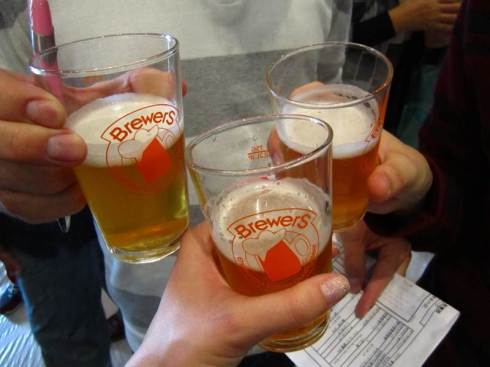
Japan makes quality rice beers, from Yebisu to Asahi and Sapporo, but traveling around the country and attending a local beer fest, we realized there is a thriving micro-brew community here. While visiting the Snow Monkeys in Nagano Prefecture we stopped at a local store. Angela always scans the candy looking for unique local Kit-Kat flavors while I check the sake section (I have not developed a taste for sake yet) and I happened to find a sample pack of a local brewery. The brewery made quality pale ales, IPAs, and even a porter. Usually Japanese breweries attempting barley and wheat based beers have difficulty getting it balanced, but these were good! I only question the authenticity of the brewery founding, as they claim it was early 1800s… prior to Japan opening to the outside world. Maybe they had a sake distillery?
When I first arrived in the land of the rising sun, I wasn’t a huge fan of green tea. I didn’t even know what matcha was, but I didn’t particularly like it.  Matcha is a finely ground, frothy green tea used in tea ceremonies in Japan. After living here (and drinking green tea) I can confidently say that green tea is an acquired taste. A few months ago, I could barely drink it, and now I find myself having green tea cravings. Especially matcha cravings! Anytime we travel, I try to order matcha for dessert, or visit a tea house to enjoy that bitter leaf. Matcha is usually served on a lacquer platter, accompanied by a traditional Japanese sweet that frequently represents the season. During the spring, tea will often be served with a cherry blossom shaped sweet, and in the fall, usually a maple leaf. Each tea house serves the sweet differently, and I appreciate the slight differences. Two of my favorite places to drink green tea in Japan are the Nakajima tea house in Tokyo and the Hokoku-ji Temple in Kamakura.
Matcha is a finely ground, frothy green tea used in tea ceremonies in Japan. After living here (and drinking green tea) I can confidently say that green tea is an acquired taste. A few months ago, I could barely drink it, and now I find myself having green tea cravings. Especially matcha cravings! Anytime we travel, I try to order matcha for dessert, or visit a tea house to enjoy that bitter leaf. Matcha is usually served on a lacquer platter, accompanied by a traditional Japanese sweet that frequently represents the season. During the spring, tea will often be served with a cherry blossom shaped sweet, and in the fall, usually a maple leaf. Each tea house serves the sweet differently, and I appreciate the slight differences. Two of my favorite places to drink green tea in Japan are the Nakajima tea house in Tokyo and the Hokoku-ji Temple in Kamakura.  The Nakajima tea house in Tokyo is famous because Emperor Meiji drank tea with Ulysses S. Grant here in 1879. The tea house is beautifully set on a pond, surrounded by the concrete jungle of Tokyo. The Hokoku-ji Temple in Kamakura is fondly called the bamboo forest, and here you can enjoy your green tea peacefully surrounded by bamboo trees. I will say that I do I have a hard time drinking the tea in three sips, as is proper, and instead choose to enjoy every last sip (which is usually about 10 for me!). How can you fully enjoy matcha in three sips? I guess I need to take a class on the tea ceremony to understand. And green tea is not limited to tea houses and travel destinations, but can be found in your local Starbucks and in green tea flavored treats. I am addicted to the matcha latte at Starbucks. And at the local grocery store I find myself buying green tea latte packets to enjoy at home. I have recently found the matcha green tea kit kat, and green tea oreos! And did I mention how much I love green tea ice-cream?? Green tea is literally everywhere in Japan, and I am excited I have fallen in love with it.
The Nakajima tea house in Tokyo is famous because Emperor Meiji drank tea with Ulysses S. Grant here in 1879. The tea house is beautifully set on a pond, surrounded by the concrete jungle of Tokyo. The Hokoku-ji Temple in Kamakura is fondly called the bamboo forest, and here you can enjoy your green tea peacefully surrounded by bamboo trees. I will say that I do I have a hard time drinking the tea in three sips, as is proper, and instead choose to enjoy every last sip (which is usually about 10 for me!). How can you fully enjoy matcha in three sips? I guess I need to take a class on the tea ceremony to understand. And green tea is not limited to tea houses and travel destinations, but can be found in your local Starbucks and in green tea flavored treats. I am addicted to the matcha latte at Starbucks. And at the local grocery store I find myself buying green tea latte packets to enjoy at home. I have recently found the matcha green tea kit kat, and green tea oreos! And did I mention how much I love green tea ice-cream?? Green tea is literally everywhere in Japan, and I am excited I have fallen in love with it.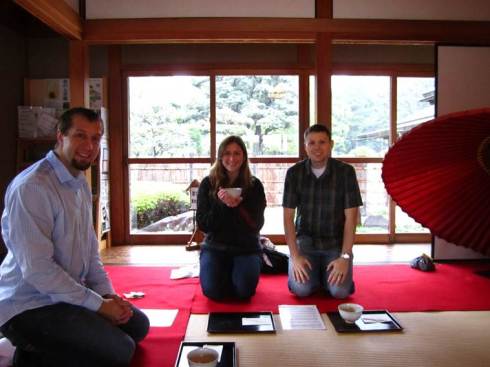
I LOVE WINE! I love going to wineries to sample local varieties. I love smelling the aromas, the way my taste buds tingle during tastings, and holding my glass up to the light to inspect the liquid in my glass. I love talking to the owners and wine makers, hearing their stories about the winery, and getting to know the winery dog. I especially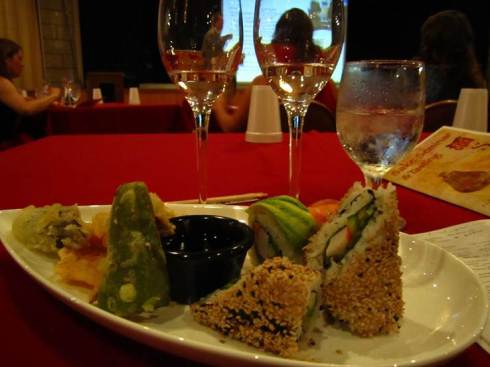 love going on wine trips with my girlfriends! All in all, I just love wine. I love the wine itself, and the experience that is wine tasting. I was really hoping that this love for wine would transfer into a love of sake tasting, but so far, that is not the case.
love going on wine trips with my girlfriends! All in all, I just love wine. I love the wine itself, and the experience that is wine tasting. I was really hoping that this love for wine would transfer into a love of sake tasting, but so far, that is not the case.
Before we moved to Japan, I had tried sake a few times, and I never really liked it. I thought maybe it was because I had never had good sake, or that perhaps it was an acquired taste. If it is in fact an acquired taste, it is a taste I would like to acquire while we are living in Japan. The O Club was holding a sake tasting and seminar, so we bought tickets and were excited to learn more about sake and to do some tastings. This was truly a seminar, and included a three hour lecture on every aspect of sake brewing, tasting, serving, and purchasing that you would ever want to know. The seminar was taught by a Sake Sommelier, Ad Blankestijn, and most of it was a bit over my head. Some things I learned about sake:
- Sake has been the national drink of Japan for almost 2,000 years.

- Sake is made of rice, koji (a mold), yeast, and water.
- There are more than 1,400 sake breweries in Japan.
- Rice comes in different qualities, like everything else. Who knew?
- Japanese sake only uses Japanese rice.
- They have to polish the rice first. The more expensive your sake, the more polished your rice.
- There are four grades of sake: Honjozo, Junmai, Ginjo, and Daiginjo.
- I still have no idea how to tell the difference between the four.
- Most quality sake is served in wine glasses.
- Sake is closely connected with Shintoism, and you will see sake barrels at Shinto shrines.
During the lecture, we sampled a variety of sake with food pairings. I greatly enjoyed the food pairings, especially the sushi and tempura. The sake on the other hand….not so much. While I’m glad that we attended this sake tasting, I still have no taste for it. Most of my glasses stayed full, as I couldn’t bring myself to have more than a few sips. Despite our first sake tasting lacking anything I could drink, I haven’t given up hope yet! We still have three years to acquire a taste for sake!



